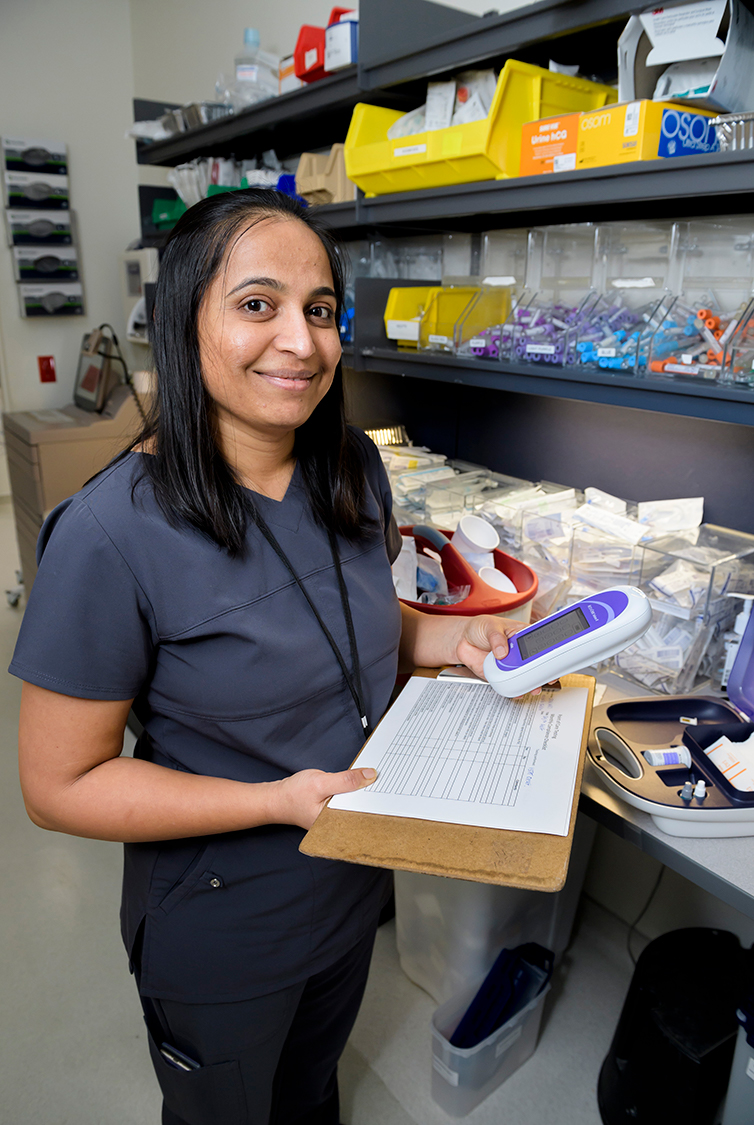 At the start of every day, Rina Kalariya sits at her desk checking the latest performance reports for the point-of-care-testing (POCT) equipment she helps maintain and manage. It’s just one part of her role as technical supervisor for the POCT group within UTMB’s Laboratory Services department, but it’s an important one.
At the start of every day, Rina Kalariya sits at her desk checking the latest performance reports for the point-of-care-testing (POCT) equipment she helps maintain and manage. It’s just one part of her role as technical supervisor for the POCT group within UTMB’s Laboratory Services department, but it’s an important one.
“It’s my job to do this initial review every day to ensure there are no outliers [out-of-the-ordinary figures] and that the machines are producing accurate results,” says Kalariya.
Producing rapid results and taking place as the patient is receiving care, POCT allows patients to receive faster diagnoses. This means they can more quickly receive the appropriate care they need. To perform this type of diagnostic screening, UTMB has specialized equipment that receives routine quality control checks and maintenance.
That’s where Kalariya and her four-person team come into play. Although they do not conduct tests at the patient bedside, the team ensures the POCT equipment, which includes instruments that can detect pregnancies, the flu virus, monitor blood glucose levels and more, is maintained and produces reliable data for the providers making decisions based on the test results. The team also trains providers on how to use the specialized equipment effectively.
As team lead, Kalariya, who has been in her current role for three years, oversees the equipment validation process. With hundreds of POCT instruments in use across the organization, data review and documentation are a big part of her job.
Pathology faculty member Dr. Christopher Zahner serves as the POCT laboratory director and works closely with Kalariya, approving the monthly quality control (QC) reports she runs for each POCT instrument. He commends her for the thorough way she approaches such a meticulous task.
“She’s the kind of person who’s focused on details,” says Zahner. “Someone who’s willing to get into the nitty gritty. That’s exactly what we need in that role.”
Gabriel Diaz, a point-of-care coordinator on Kalariya’s team, echoes Zahner’s sentiment.
“Rina adds a strong sense of organization to our department,” he says. “She is able to see everyone’s strengths and skills and uses that to guide our work without micromanaging.”
Originally from India, Kalariya got her start at UTMB in 2006 as a bench tech in the Chemistry lab, where she honed that ability to focus, organize information and attend to details to ensure the integrity of the samples and specimens she handled.
She and her team of coordinators—the majority of whom have a laboratory background similar to hers—have a shared understanding of the precision required for POCT.
To share best practices and the importance of approaching POCT with that same precision, Kalariya’s group regularly offers two different trainings –one designed specifically for nurses and the other designed for medical students. The classes cover how to use and maintain various POCT instruments, Joint Commission Standards for POCT, specimen collection, charting results and more. Attendees even have a chance to gain hands-on experience in simulation labs.
These trainings are critical, as they emphasize the sensitive nature of POCT and offer tips on how to avoid common pitfalls that may lead to inaccurate or unusable results.
Given the benefits of the practice, point-of-care testing continues to increase throughout the health care industry, and UTMB’s campuses are no exception.
Responsible for servicing the POCT needs of the entire institution, members of Kalariya’s team frequently visit Angleton and League City to ensure equipment there is working as it should and providers have what they need.
POCT has changed quite a bit from when Kalariya started a one-person operation focused solely on John Sealy Hospital.
“When Jennie Sealy came up, we expanded, followed quickly by the League City Campus, while we simultaneously worked to take over POCT in Angleton,” she says.
With the soon-to-open Clear Lake Campus on the horizon for UTMB, the POCT team will remain busy.
“We are bringing in lots of new instruments for the campus, so we have to make sure they are compatible with any existing equipment we’ll be using,” says Kalariya. “We’ve been performing lots of tests and comparisons to ensure we’re acquiring tools that produce accurate, reliable results for our providers and their patients.”
When she’s not working on the Clear Lake venture, documenting equipment QC reports or leading a training, Kalariya makes a point to check in with her team, POCT manufacturers and vendors, and key POCT equipment users, dubbed “super users” within the institution. Responsible for POCT in a particular group or area, super users serve as liaisons between their specific unit or department and Kalariya’s team.
And, there’s always the chance she or one of her team members will be called to scrub in and assist with a liver transplant, as they did for each of the 19 such surgeries performed at UTMB in fiscal year 2018.
“The POCT instrument we use for liver transplants is very critical because it monitors how the blood is clotting and whether or not a patient is at risk for bleeding out during surgery,” says Kalariya.
The machine used for this specific procedure is known as a real-time TEG (thromboelastography) and anesthesiologists use the results from it to determine whether or not the patient needs blood products during the procedure.
“Rina and her team are integral in transplant services, getting patients properly assessed and cared for,” said Zahner. “Our team is very well aware of how lucky we are to have her.”
At the end of the day, Kalariya enjoys what she does and knows she’s making a difference along the way.
“Every day is a different challenge, which is why I love my job,” says Kalariya. “I’m so glad I play a role in taking care of the patients. That’s what I enjoy.”